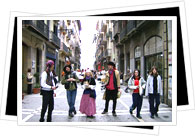The Basque people place great emphasis on preserving and promoting the various aspects of their unique culture. Like other aspects of the Basque culture, Basque folk music is a symbol of ethnic pride and identity. The music took on even stronger meaning as a celebration of the Basque culture and language followwing the repressive dictatorship of ultra-nationalist Francisco Franco, who attempted to essentially eradicate the Basque culture.
 Basque music has a very collective character, in that much of it is meant to be played by large groups. In the late 19th century, a major surge of Basque cultural pride sparked the formation of large choirs which sang traditional folk songs in the Basque language. For this reason, the Basque Country and Navarra today have numerous choral groups, orchestras, etc.
Basque music has a very collective character, in that much of it is meant to be played by large groups. In the late 19th century, a major surge of Basque cultural pride sparked the formation of large choirs which sang traditional folk songs in the Basque language. For this reason, the Basque Country and Navarra today have numerous choral groups, orchestras, etc.
 The most widespread form of Basque folk music is called Trikitixa, which is an intricate and fast-paced music style that revolves around a diatonic accordian and a tambourine and that originally accompanied a country dance. Like many traditional music styles around the world, Basque music has a variety of traditional instruments - aside from the diatonic accordian and tambourine - that date back hundreds of years... if not more! Some of these instruments include:
The most widespread form of Basque folk music is called Trikitixa, which is an intricate and fast-paced music style that revolves around a diatonic accordian and a tambourine and that originally accompanied a country dance. Like many traditional music styles around the world, Basque music has a variety of traditional instruments - aside from the diatonic accordian and tambourine - that date back hundreds of years... if not more! Some of these instruments include: